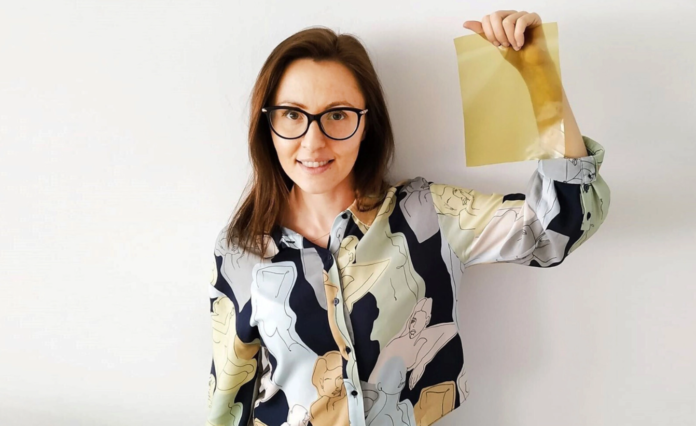PUBLIKACJA DZIĘKI UPRZEJMOŚCI HELLO ZDROWIE (www.hellozdrowie.pl)
It is 100% biodegradable, decomposes within four weeks, extends the freshness of food products, kills bacteria, and will soon eliminate viruses. The invention of the Polish researcher Dr. Ewelina Jamróz. A natural film made of red algae and gelatin turns our thinking about ecology on its head.
Anna Jastrzębska: How did you come up with the idea of making seaweed and gelatin film?
Ewelina Jamróz, University of Agriculture in Krakow: The idea came from the supervisor of my doctoral dissertation, Prof. Andrzej Para, who studied furcelleran, that is polysaccharides (complex sugars) from red algae. While working on my PhD dissertation I continued his research – I made complexes (complex compounds – chemical compounds containing at least one central atom, surrounded by other atoms or groups of atoms – editor’s note) of furcelleran with other proteins. I complexed furcelleran with, among others, whey protein and gelatin; at that stage it had no application yet. When I started looking for this application, it turned out that it was possible to make film from simple polysaccharides. So I started playing with it. First, I created film in such a basic version…
And then you started adding various interesting things, right?
Yes, from the beginning I wanted my film – apart from being completely biodegradable – to have some added value. That’s why I started adding various natural ingredients to it, e.g. yerba mate extract.
What was the purpose?
Yerba mate has antioxidant properties – this is very important for food. Meat or fish oxidize very quickly, and oxidation causes food spoilage. The film that has oxidative properties is an active film. Not only does it protect food, but it also inhibits its oxidation, thanks to which the products wrapped in it remain fresh for a longer time. This is great news for producers of food products – they not only receive a packaging that decomposes in 4 weeks, i.e. it doesn’t pollute the environment at all, but the food remains fresh for 2-3 days longer. And such 2-3 days for large producers is sometimes profit in billions of zlotys.
Another feature of my film is its antimicrobial properties.
By adding nanoselene or nanosilver to it, the film kills bacteria, which also makes longer storage of food possible.

In the current situation, I must ask this question: can such a film kill viruses too?
Yes, it can! And making anti-virus film is not a problem! We are just starting to make such a film – in May we are going back to the laboratory. We are just waiting for bioactive antiviral peptides, which are currently being synthesized in the Czech Republic, and when they come to us, we will get down to work.
The coronavirus has shown us a new direction. I can imagine that the film that will have both anti-virus and anti-bacterial properties will be perfect for covering tables or benches in hospitals. It probably sounds a bit abstract at the moment, but when I started this project, it also seemed unreal. And now look how it is evolving.
What’s happening?
There are a lot of companies interested in implementing my solution. We are talking to many producers, in fact we are already at the final stage of these talks. If everything goes well, in about a year, our film should already be on the market. I hope it works out.
Is this solution profitable for producers at all?
It is very profitable, because all the products you need to make film are really cheap. Of course, we cannot fully compare our product with plastic bags. Because these are actually granules put into a suitable mixer, which then inflates them – the cost of their production is almost equal to zero. However, due to restrictions and directives of the European Union that are coming into force in Poland, producers of synthetic packaging will sooner or later have to look for alternatives. The alternative we offer can be implemented by all these companies – and it is not a big cost. The production cost of a square meter of my film is about 50-60 groszes.
Synthetic films are cheaper even by half, but looking ahead, we will have to switch to more responsible solutions. Our planet has already suffered enough.
And will the so-called average Pole be able to wrap a carrot in such a film?
Of course! Each addition that we add to the film can give a new direction to its application. One added element will improve the barrier to water vapour, thanks to which the film will be great as a packaging for products that cannot dry out. But we can also make film that allows water vapour to penetrate freely, making it an ideal solution for fruit and vegetables. In their case, a good air flow and adequate humidity must be ensured. For example: a carrot in a plastic bag – after 2 hours we see condensed water vapour inside the plastic bag, because there is no flow of air.
What other applications do you see for your invention?
There are many of them. My film will work well, for example, . with dog droppings – it will collect what you need to pick up from the street, and then you can throw it in a composter. There are really many different directions we can go when producing this film. It will depend on the consumers’ needs which properties they choose for themselves.
Will seaweed film change our thinking about environmental protection?
I hope so. If people have an alternative, they will want to choose better solutions. This change will not take place quickly or easily, but it must happen and I think that we are finally starting to move in the right direction.
Until recently, we could not imagine that we would be shopping without plastic bags, and today almost everyone goes to the shops with a cotton bag in their hands.
Even 30 years ago, shelves in stores were full of synthetic cleaning products. Today, there are a lot of washing powders, rinsing liquids, cleaning agents that are not so synthetic, packed with harmful substances, getting into the soil together with water. Because the group of people aware that man is harming the planet and destroying it is growing. Therefore, the number of consumers interested in such products is increasing.
Unfortunately, there is also a growing group of people who want to do good, but fall for the tricks of producers.
So true. Packages marked as biodegradable, which are not biodegradable at all, make me really furious. A person who decides to sell them in this way does not commit any crime because in Poland there are insufficient legal regulations. But I am outraged by the fact that packaging consisting of 95% synthetic material (which needs 100 years to decompose into microplastic) and only 5 % starch (which is actually biodegradable) can be considered biodegradable. This is cynicism and a real sham! One buys such a package, thinking that you are caring for the planet when in fact you are being led by the nose – because people are lazy, usually they do not have enough determination to read the list of ingredients in detail. It scares me that the UN has calculated that by 2050 there will be more plastic than fish in the oceans and seas.
That is why I can take full responsibility, with a clear conscience, for my film, as it is biodegradable in 4 weeks, and in addition it is an excellent breeding ground for bacteria and micro-organisms that live in the ground. So, it also really improves the quality of soil (of course, the amount of film in the soil also needs to be controlled, because excess sugars can lead to the development of fungi or soil moulding, but this is still incomparable to the damage that plastic currently causes).
Therefore, I believe that even replacing 10 % of all synthetic packaging with my films – in those branches where it is easy and feasible – will greatly improve the situation of our planet.
This topic is valid because plastic bags came to life like zombies during the coronavirus epidemic.
Yes, from the very beginning I was afraid of the virus from this point of view. I knew that plastic gloves, plastic bags, and other synthetic protective measures would cover the streets. This is a tragedy.
Journalists call me asking if my films will be able to completely replace the film from China. No, unfortunately they will not be able to, because they do not have 100 % barrier properties (some have this barrier at a level of 90%, others 70 or 80%, and the virus is so tiny that it must have 100% barrier properties). But it’s not that my film solves all problems.
In the current situation of the epidemic, it would be enough for people to pay attention to where used protection products are thrown away, not to throw them away just anywhere.
I think that everyone can sweep their own backyard to do something good for the Earth. Sort garbage, do not use plastic bags when it is not necessary, place a container under the tap when washing the fruit, and water plants with the water “saved” in this way… These are small things, but if everyone did it in their home, we would not have such a drama.
I have been more focused on that since I had a baby. I may not live to see this, but the scenarios that there will be no water, that people will fight for it, that they will live in a world where there is a lack of clean air, still come to the forefront. I don’t want my daughter to live in such a reality.
Interviewed by Anna Jastrzębska hellozdrowie.pl








